 Image search results - "temple" Image search results - "temple" |

Entrance and stairs going up to Shorinzan, a small hill. 少林山
|
|

Established in 1617, Tsukiji Hongwanji temple is the Tokyo headquarters of the Nishi Hongwanji Jodo Shinshu sect. The present temple, based on Indian architecture, was built in the 1930s.The temple is the only one in Japan which is under the direct control of the sect. Its head priest is the Monshu Abbot himself. April 8 is observed as Buddha's birthday, called Hana Matsuri ("Flower Festival) in Japan.
|
|

Gate to Kitain, a Tendai Buddhist temple. Part of Kawagoe's National Important Traditional Townscape Preservation District (重要伝統的建造物群保存地区).
|
|
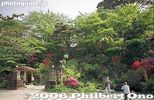
Garden
|
|

Tsukiji Hongwanji temple gate with wisteria crest.The emblem is a wisteria flower and symbol of the Jodo Shinshu sect.
|
|

Kitain Main hall, Kawagoe
|
|

Garden (photos taken in early May)
|
|

Temple gate and flag
|
|

Main hall
|
|

Shorinzan Daruma Temple 少林山達磨寺Daruma offerings on both sides of the temple.
|
|

Play room for kids on Hanamatsuri
|
|

Pagoda at Kitain temple, Kawagoe
|
|

An Australian praying at the temple
|
|

Hanamatsuri altar
|
|
|
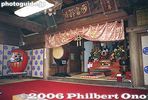
Inside the Daruma temple, Takasaki.
|
|

Pouring sweet tea over the BuddhaWhen the Buddha was born in Lumbini Garden in Nepal, sweet rain is said to have fallen. Thus, sweet tea is poured over the baby Buddha statue in the Hanamatsuri altar.
|
|
|
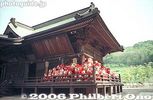
Right balcony of temple.
|
|

Hanamatsuri celebrates the Buddha's birthday on April 8. This is Tsukiji Honganji in Tokyo.The flowers symbolize Lumbini Garden where the Buddha was born in present-day Nepal.
|
|

Over 500 stone statues of Rakan Buddhist disciples
|
|

Right balcony of temple.
|
|

Baby Buddha statueLadles are provided for pouring the sweet tea over the Buddha. Sweet tea is also provided to worshippers. It symbolizes the sweet rain that fell when the Buddha was born.
|
|

Carved during the 18th and 19th centuries.
|
|
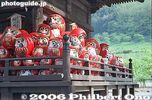
Right balcony of Daruma temple, Takasaki.
|
|

Children dressed for the chigo parade, Tsukiji Hongwanji, TokyoIt took a long time before they could get all the kids to settle down for the picture and to get all the mothers out of the picture.
|
|

五百羅漢
|
|

Meaning "Long Life Temple," Chojuji's Hondo temple hall is a National Treasure. It belongs to the Tendai Buddhist Sect and one of the Konan Sanzan Temple Trio along with Jorakuji and Zensuiji Temples.Chojuji temple Entrance gate + fall colors.
|
|

A stone's throw from Chojuji Temple, Jorakuji Temple (est. 708) of the Tendai Buddhist Sect boasts two National Treasures with its main hall and three-story pagoda. It is one of the Konan Sanzan Temple Trio accessible by bus from JR Ishibe Station.In the deep-green forest, you can see part of the pagoda's roof.
|
|
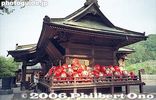
Right balcony of temple.
|
|

Marker and side road to Lord Gamo (Gamoh) Ujisato's gravesite. Near Aizu-Wakamatsu City Hall. Gamo Ujisato (1556-1595) was a feudal lord from Hino, Shiga Pref. He built Tsurugajo Castle and named the town Wakamatsu, after a place in his hometown.
|
|

Children dressed for the chigo parade (photo session), Tsukiji Hongwanji, Tokyo
|
|
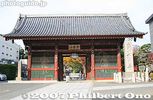
Belonging to the Buzan School of the Shingon Sect of Buddhism, Gokokuji Temple was built by the mother of Shogun Tokugawa Tsunayoshi in 1682. The Gekkoden Hall was moved here from Miidera temple in Otsu, Shiga Pref. The Tahoto Pagoda was modeled after the Tahoto at Ishiyamadera in Otsu, Shiga. Okuma Shigenobu, founder of Waseda Univ., is also buried here. This is the entrance to Gokokuji Temple, Niomon Gate. It's right next to Gokokuji Station on the Yurakucho subway line. 仁王門
|
|

Senryuji Temple, Sanmon Gate, which is the front gate. Reconstructed in 1859, and renovated in 2006-2007. The temple was founded by a monk named Roben 良弁 in 765. 山門
|
|

People coming to Takahata Fudoson temple on Feb. 3, Setsubun day.
|
|

Sando worship path to Taishakuten temple. Shibamata is in Tokyo's Katsushika Ward bordered by the Arakawa River in the west and by the Edogawa River in the east.
|
|

Belonging to the Shingon Sect's Buzan school, this is one of Tokyo's major temples. The real name is Sojiji (總持寺), but everyone calls it Nishi-Arai Daishi.The temple grounds feature many flowering trees and plants including an unusual species of cherry blossoms which bloom in winter. Daishi-mae Station. Much larger station than I expected. Probably for the New Year's crowds. 大師前駅
|
|

Japan's most famous temple, with the world's oldest wooden buildings (over 1,300 years old), is also the country's first World Heritage Site. Also called Ikaruga-dera, the temple is the headquarters of the Shotoku-shu Buddhist Sect. Path to
|
|
|

Right balcony of temple.
|
|

Ujisato was married to Oda Nobunaga's second daughter Fuyuhime. He died at age 40. One theory says that he was poisoned by Toyotomi Hideyoshi. Entrance to Lord Gamo Ujisato's gravesite within Kotokuji temple in Aizu-Wakamatsu, Fukushima..
|
|

Going to the chigo parade's starting point
|
|

After you pass through the Niomon Gate, this is what you see.
|
|

View after passing through the Sanmon Gate. Bell Tower ahead.
|
|

Sando path to temple from train station. 参道
|
|

Takahata Fudoson temple entrance 高幡不動尊
|
|
|

Daishi-mae Station 大師前駅. Nishi-Arai Daishi Temple was said have been founded by Priest Kobo Daishi in 826. One of the Kanto Region's Big Three Daishi Temples.
|
|

Admission charged. The 1,000 yen ticket gets you into the three major sights.
|
|

Psst, wanna know a secret? Kitain Temple, Kawagoe
|
|

Right balcony of Daruma temple, Takasaki
|
|

Entrance doors to Lord Gamo Ujisato's gravesite within Kotokuji temple which is a Zen temple of the Rinzai Sect.
|
|

White elephant to anchor the parade. Notice the Buddha altar riding on the top. Before she gave birth to the Buddha, Queen Maya dreamed of a white elephant.
|
|

Well
|
|

Bell Tower, reconstructed in 1844. It stands between the Sanmon Gate and Hondo main hall.
|
|

Entrance to Takahata Fudoson Kongoji temple
|
|

The setsubun bean-throwing starts with a memorial service, then a procession of the bean throwers and priests.
|
|

Sando worship path to Taishakuten temple
|
|

The main path to the temple is lined with the usual shops, but it is not aligned with the train station. The path from the train station takes a different route.
|
|

Nandaimon Gate 南大門
|
|

Oh man, I forgot my glasses!
|
|

Daruma closeup
|
|

Family crest on door. (Not the Gamo crest.)
|
|

Start of the Hanamatsuri parade which also promotes traffic safety.The starting point was a nearby park.
|
|

Bell Tower
|
|

Well
|
|

Takahata Fudoson Kongoji temple, Hino, Tokyo 高幡不動尊金剛寺
|
|

Priests in setsubun procession within the temple grounds.
|
|

The path is lined with shops.
|
|

Main path to temple
|
|

Horyuji temple, Nandaimon Gate, National Treasure 南大門(国宝)
|
|

Boo-hoo! My cat ran away!
|
|

Left balcony of temple.
|
|

Grounds of Lord Gamo Ujisato's gravesite within Kotokuji temple. Since Ujisato was a Christian lord, it is ironic that he be buried in a Buddhist temple in Kyoto and Aizu-Wakamatsu.
|
|

Parade starts...
|
|

Map of temple grounds. Belonging to the Buzan School of the Shingon Sect of Buddhism, Gokokuji temple was built by the mother of Shogun Tokugawa Tsunayoshi in 1682.
|
|

Hondo main hall. 本堂
|
|

Niomon Gate, Important Cultural Property from the Muromachi Period 仁王門 (重要文化財)
|
|

Priests in setsubun procession within the temple grounds.
|
|

Sanmon Gate, the main gate. 山門
|
|

Founded in 607 by Prince Shotoku Taishi, Horyuji is one of Japan's most famous temples, with the world's oldest wooden buildings (over 1,300 years old). Japan's first World Heritage Site.
|
|
|
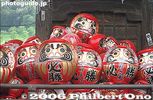
Daruma dolls can never be knocked over since they always stand upright.
|
|
|

Baton-twirling club from the Chiyoda Jogakuin Junior/Senior High School followed by the elephant千代田女学院
|
|

Steps going up to an inner gate called Furomon 不老門
|
|

Hondo main hall. 本堂
|
|

Niomon Gate
|
|

Priests in setsubun procession coming through Niomon Gate
|
|

Sanmon Gate
|
|

Also called Ikaruga-dera, the temple is the headquarters of the Shotoku-shu Buddhist Sect founded by Shotoku Taishi.
|
|
|
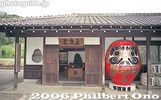
Daruma Museum (next to temple)
|
|

Poem monument reads 限りあれば吹かねど花は散るものを心短き春の山風
|
|

Chigo children
|
|

Furomon Gate (Ageless Gate) 不老門
|
|

Carved stone lantern in front of Hondo
|
|

Fudo Hall on left and Horinkaku on the right, Takahata Fudoson Kongoji temple, Hino, Tokyo
|
|

Priest blowing a conch shell
|
|

Food stalls lead you to the main worship hall.
|
|

西院伽藍
|
|
|
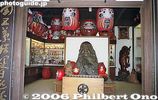
Entrance to Daruma Museum (one room only)
|
|

Path to Lord Gamo Ujisato's gravesite
|
|

On the road in front of the temple
|
|

View from Furomon Gate
|
|

Carved stone lantern
|
|

Priests in setsubun procession coming through Niomon Gate
|
|

Incense burner 大香炉
|
|

Dai-Hondo Hall, Nishi-Arai Daishi, Tokyo 大本堂According to legend, when prayers were offered to save villagers from an epidemic, pure water gushed out of a hitherto dried-up well and got rid of the plague. Since the well was on the west side of the temple hall, this area came to be called "Nishi-Arai" (New Well in the West). The temple is famous for warding off fire and misfortune.
|
|
|

Daruma exhibits (the giant daruma on the left is for the late Fukuda Takeo, former prime minister from Gunma.
|
|

Lord Gamo Ujisato's grave.
|
|

Baton-twirling club, Tsukiji Hongwanji, Tokyo 千代田女学院 バトン部千代田女学院
|
|
|

View from Hondo hall
|
|

Festival beauties included.
|
|

Putting smoke on one's head.
|
|

The shop sells kusa dango (mugwort dumplings with real grass inside), the local specialty. Photo: Nitenmon Gate in view
|
|

Incense burner
|
|

Map of Horyuji. Large complex of buildings. Only two precincts are open to the public.
|
|

The giant daruma on the left is for Nakasone Yasuhiro, and the right is for the late Obuchi Keizo, both former prime ministers from Gunma.
|
|

Lord Gamo Ujisato's grave. This is a secondary grave, where his hair is buried. His main grave is at a temple in Kyoto where he died at age 40.
|
|

Female schoolmates of the baton twirlers block the cameras of unrelated photographers when the baton twirlers passed. カメラ小僧を妨害するバトン部の先輩たち。This was the first time for me in Japan to see people blocking photographers from taking pictures at a festival. They did it to me as well. If they don't want to be photographed, why do they appear in this public festival??
妨害しても無駄だと思いますが。撮られるのがいやでしたら、まつりに出ない方がいいですよ。
|
|
|
|
|

Temple priest
|
|

Fudo Hall from the 14th century, Important Cultural Property 不動堂 (重要文化財)
|
|

Sanmon Gate 山門
|
|

Toward the end of the shop-lined mall, you will see this Nitenmon Gate of the Shibamata Taishakuten Temple, formally known as Daikyoji. 二天門
|
|

Lantern
|
|

Horyuji and World Heritage Site (Japan's first) marker
|
|

Fall colors are also nice. Accessible by bus from Ishibe Station or walk from Jorakuji. Path to temple. MAP
|
|

In the deep-green forest, you can see part of the pagoda's roof. You can walk to Jorakuji (means "Constant Comfort Temple") from Chojuji Temple. From Ishibe Station, best to take a bus to Chojuji first, then walk downhill to Jorakuji. Entra
|
|

Entrance to Chomeiji Temple. MAP
|
|

Different daruma from all over Japan. Very interesting.
|
|
|
|

Band from the Chiyoda Jogakuin Girls Junior/Senior High SchoolNo problem photographing them.
|
|
|
|

Names of the bean throwers.
|
|

Fudo Hall
|
|

Nagahama's most famous temple belongs to the Jodo Shinshu sect, Otani school. Omotesando path to Daitsuji.
|
|

Hosenji temple in Nakano-ku, Tokyo. Belongs to the Shingon-shu Sect, Buzan School. 宝仙寺
|
|

Wood carvings on Nitenmon Gate
|
|

Dai-Hondo Hall 大本堂
|
|

Sai-in Garan West Precinct 西院伽藍
|
|

Jindaji temple, Hondo main hall
|
|

The tombstone has five segments each with a kanji character. 五輪塔
|
|

The elephant follows the band.
|
|
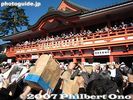
Start of setsubun bean throwing (mamemaki) by minor celebrities. 豆まき
|
|

Buddha statue with Tahoto Pagoda in background
|
|

Jizo statues
|
|

Fudo Hall offertory box and worshippers
|
|

Omotesando is lined with shops.
|
|

Hondo hall 本堂
|
|

This temple serves as a recurrent backdrop in the Tora-san series. The temple's priest is played by the humorous Ryu Chishu who actually came from a family of Buddhist priests. Photo: Bell tower
|
|

Altar inside Dai-Hondo Hall 大本堂
|
|

三経院 National Treasure
|
|
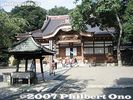
Jindaji temple, Hondo main hall and incense burner
|
|

Explanation of the kanji characters on the tombstone. From top to bottom, the characters are for "Sky, wind, fire, water, and earth."
|
|

Entering the temple gate
|
|

Kannon-do main worship hall 観音堂(本堂)Gokokuji Temple has held large funerals for some famous people like singer Yutaka Ozaki in 1992.
|
|

Entrance to the Benzaiten Pond Greenery Preservation Area. Adjacent to Senryuji Temple, it used to be part of the temple grounds. The small loghouse is an activity space. 狛江弁財天池緑地保全地区
|
|

Ryuoji Temple 龍王寺
|
|

Offertory box
|
|

Miss Nippon
|
|

Red paper umbrellas decorate the path.
|
|

Hondo hall 本堂
|
|

The Nitenmon Gate was completed in 1896 and features wooden statues of Zocho and Komoku, two of the four Devas which guard the four cardinal directions from demons.
|
|

View from Dai-Hondo Hall
|
|

Horyuji temple Five-Story Pagoda and Kondo Hall, National Treasures 五重塔 金堂
|
|
|
|

Portrait of Lord Gamo Ujisato
|
|

Final performance
|
|

Kannon-do main worship hall 観音堂(本堂)
|
|

The area is well forested and maintained by volunteers. The area is open to the public only on certain days.
|
|

Ryuoji Temple 龍王寺
|
|

Miss Nippon throw beans, but not very far.
|
|

Horinkaku and Niomon on right.
|
|
|
|

Kobo Daishi statue
|
|

Founded in 1629 by a priest named Nitchu and his disciple Nichiei, the temple belongs to the Nichiren sect of Buddhism.
|
|

Winter-flowering cherry blossoms
|
|
|
|

Wedding at Jindaiji temple
|
|
|

The parade was over after 30 min. (11:30 - 12 pm).
|
|

Daibutsu Buddha statue
|
|
|

Ryuoji Temple belongs to the Tendai Sect. 龍王寺
|
|

Horinkaku 宝輪閣(お札所)
|
|

Kimono beauties and beans do mix well.
|
|
|

Inside Hondo hall 本堂
|
|

The present Naiden (Inner Sanctuary) was completed in 1915. Keyaki (zelkova) was used for all the wood in the building. The present Haiden (Worship Hall) was completed in 1929. Photo: Taishaku-do Hall 帝釈堂
|
|

Winter-flowering cherry blossoms and Dai-Hondo Hall
|
|

Five-Story Pagoda and Kondo Hall, National Treasures 五重塔 金堂
|
|

Wedding at Jindaiji temple
|
|

Kotokuji temple
|
|

Chigo kids enter the temple
|
|

Daibutsu Buddha statue
|
|

This greenery area features a variety of flora and fauna, insects, and birds such as the kingfisher.
|
|

Women in kimono is a must on Setsubun day.
|
|

Roof of Horinkaku 宝輪閣
|
|

Sandal store
|
|

Inside Hondo hall 本堂
|
|

Taishakuten is the god Indra from Brahmanism, a Hindu religion. Being the god of rain and thunder, Indra was a powerful warrior god that was adopted by Buddhism as a protector. Photo: Glass wall protecting the exterior of Taishaku-do Hall.
|
|
|
|
|

Jindaiji soba restaurants
|
|

Hanamatsuri service inside the templeNotice the Hanamatsuri altar at the center.
|
|

Tahoto Pagoda at Gokokuji temple in Bunkyo, Tokyo. Built in 1938 modeled after the original Tahoto Pagoda at Ishiyama-dera temple in Otsu, Shiga Prefecture. 多宝塔
|
|
|

Minor female idols also on hand to throw beans.
|
|

Statue of Hijikata Toshizo from Shinsengumi. 土方歳三像
|
|

Getting closer to the Sanmon Gate
|
|

Three-story pagoda 三重塔
|
|

It was believed that Indra would step in and chase away the demons causing calamities to the followers of Buddhism. Photo: Wood Carving Gallery (admission charged)
|
|

Winter-flowering cherry blossoms, Nishi-Arai Daishi, Tokyo 寒桜
|
|

Goju-no-To (Five-Story Pagoda), National Treasure, Horyuji. The size of the roof gets smaller toward the top of the structure. 五重塔 仏舎利
|
|
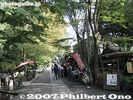
Jindaiji soba restaurants
|
|

Hanamatsuri service inside the Tsukiji Hongwanji temple
|
|
|

Bamboo grove
|
|

節分会に吉井怜、三津谷葉子、福下恵美が豆まく
|
|

Statue of Hijikata Toshizo. 土方歳三像
|
|

Omotesando as seen from Sanmon Gate.
|
|

Goeido Hall housing Kobo Daishi image. 御影堂
|
|

The side and rear exterior walls of the Taishakudo are blanketed with panels of detailed woodcarvings. They are the most outstanding feature of Shibamata Taishakuten Temple.. 彫刻ギャラリー
|
|
|

Horyuji Goju-no-To (Five-Story Pagoda) National Treasure. Houses a few bones of Shakyamuni Buddha. 五重塔
|
|
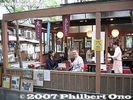
Jindaiji soba restaurant
|
|

Hanami-do housing a statue of the baby Buddha on which sweet tea is poured. When the Buddha was born in Lumbini Garden, flowers bloomed.
|
|
|

Benzaiten Goddess
|
|

Bikini idols Yoshii Rei, Mitsuya Yoko, and Fukushita Megumi throwing beans on Setsubun
|
|

Rear view of Hijikata Toshizo statue
|
|

Daitsuji temple Sanmon Gate 山門
|
|

Temple grounds as seen from the Hondo Hall
|
|

There are ten large carvings (each 2.27 meters by 1.27 meters) depicting scenes from the Lotus Sutra (Hokekyo).
|
|

Winter-flowering cherry blossoms 寒桜
|
|

The Five-Story pagoda has a thick wooden pillar in the center going from the bottom to the top. Only the top part of the building is in contact with the central pillar and works to counterbalance earthquake swaying.
|
|
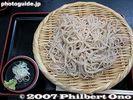
Soba noodles
|
|

Shinsengumi monument 新選組両雄の碑
|
|

Praying to the Hanamatsuri altar
|
|
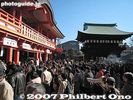
After the first bean-throwing session.
|
|
|

The area includes two ponds. Here's one called Hyotan Pond. ひょうたん池
|
|

Benten Pond and Hall 弁天池・弁天堂
|
|

2006 NHK Taiga Drama "Komyo ga Tsuji" Exhibition banner and gate entrance.
|
|

Pagoda and pile of setsubun boxes
|
|
| 5745 files on 23 page(s) |
1 |
 |
 |
 |
 |
|